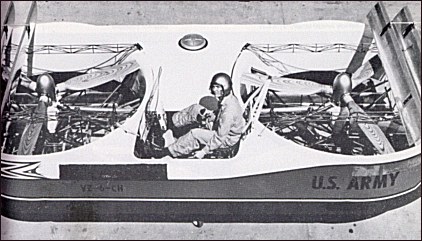
| Chrysler VZ-6 1982 |  |
 |

| Chrysler VZ-6 1982 |  |
 |
|
In 1956 the Army solicited proposals for a light aerial utility vehicle that would, it was hoped, combine the versatility and ease of operation of the ubiquitous Jeep with the ability to overfly particularly hazardous or difficult terrain. Army planners envisaged a simple and robust craft capable of both hovering and low-altitude forward flight at moderate speeds, with the ability to carry a 450kg payload for several hours at a "cruising altitude" of between 1.5 and 4m. Several firms submitted design proposals, and in early 1957 contracts for prototype development were awarded to Chrysler, Curtiss-Wright, and Piasecki.
Chrysler's entry in the "Flying Jeep" competition was a single-place craft that used one 500hp reciprocating engine to drive two dueled propellers. The engine was located in the center of the rectangular-shaped vehicle, next to the off-set pilot's position, with one dueled fan forward and one aft. Rubber skirts around the outside of the vehicle's bottom edge helped sustain the fan-generated lift, while forward propulsion resulted from lowering the craft's nose and using duct-mounted vanes to deflect some of the propellers' slipstream to the rear.
The Army took delivery of two Chrysler VZ-6 prototypes (serials 58-5506 and 58--5507) in late 1958, and tethered flight testing began in early 1959. At a gross weight of some 1080kg the VZ-6 was overweight and underpowered, and both examples additionally suffered from severe lateral stability problems. Indeed, during the course of the first non-tethered "flight" the first prototype flipped completely over. The pilot escaped without serious injury but the craft itself was damaged beyond economical repair. Rather than subsidize further costly design modifications the Army chose to terminate the VZ-6's development, and both prototypes were disposed of in 1960. S.Harding "U.S.Army Aircraft since 1947", 1990
|